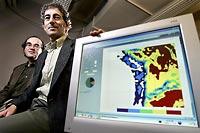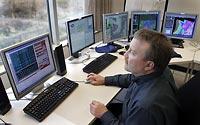| Traffic | Weather | Your account | Movies | Restaurants | Today's events |
|
|
Tuesday, November 29, 2005 - Page updated at 12:00 AM Weather reports that map out all the scenariosSeattle Times staff reporter
Before embarking on a recent fall hike, Adrian Raftery checked the weather forecast. Rain likely throughout the north-central Cascades, it said. But when he logged onto an experimental University of Washington Web site, Raftery saw a more nuanced picture: While the chance of showers was higher than 40 percent in some areas, on the west side of Mount Baker it was a scant 20 percent. Early next year, the forecast system that allowed Raftery, a UW statistician, to stay dry on his hike will be available to anyone with a computer. A click of a mouse will yield a wealth of information until now available only to meteorologists. Based on an innovative new approach called "ensemble forecasting," the UW system could be a model for weather reports of the future, Raftery said. When the public version of the Web site is up and running, it will provide details most forecasts omit or gloss over, from the mathematical odds of a hard freeze two days from now to the probability next weekend's high temperatures will fall within a given range. The system also will acknowledge what anyone who has watched fair-weather plans dissolve into rain has long suspected: Sometimes weather predictions are rock solid and sometimes they're as iffy as a lottery ticket. Information www.atmos.washington.edu/~ens/uwme.cgi In the meantime, a very rough version, oriented to scientists, is available here: bma.apl.washington.edu/ "We now have the ability to tell you how confident the forecast is," said UW meteorologist Cliff Mass, one of the leaders of the four-year research project. "This is a whole new way of doing weather prediction." Traditional forecasting relies on computer models and the expertise of meteorologists to assess the ever-shifting atmosphere and produce a single, best prediction. The public is presented with one high temperature and one low temperature for each day, even a week into the future. It looks impressively precise, but Raymond Ban, chief of meteorology for the Weather Channel, said seven-day temperature forecasts prove accurate only about 5 percent of the time. "We pretend to know things we don't," said Ban, who is leading a scientific panel to help the National Weather Service design forecasts with more detail and reliability yardsticks. Embracing the chaos Ensemble forecasts are transforming weather prediction by embracing the inherent chaos summed up in the Butterfly Principle: Tiny, unpredictable shifts in the atmosphere  like those caused by a butterfly's wings  can lead to major changes in the weather. Traditional forecasts essentially ignore that uncertainty. Meteorologists plug the best available weather observations into their computer models and hope for the best. Ensemble forecasters hedge their bets. Instead of starting with a single set of weather data, they tweak the initial conditions slightly to generate a range of plausible starting points. Then they conduct multiple computer runs with multiple models. The end result is multiple predictions that map out the universe of weather possibilities. How did the forecasters
do?
Is the ground white this morning? While the National Weather Service was forecasting 1 to 2 inches of snow accumulation for the Seattle/Everett/Tacoma area, the University of Washington's new "ensemble" system said mild, southeasterly winds from the Cascades would make it too warm for snow. The UW and the NWS agreed that significant snowfall was likely in the Kitsap Peninsula and Hood Canal area. "Ensembles allow you to come up with a range of forecasts and an idea of how uncertain they are," Mass said. In the National Weather Service office overlooking Lake Washington, science officer Brad Colman demonstrated the method. A computer map from the weather service's large-scale ensemble system showed two sets of curving lines, one red, one blue, outlining the path of the jet stream. Each line represents a separate computer run, and all of them agreed the jet and its stormy weather would pass well north of Washington for the next several days. Five days out, the map became a tangle of lines. "This is what's affectionately referred to as a spaghetti plot," Colman said. Spaghetti means the models don't agree, and the forecast is highly uncertain. But rarely is that uncertainty mentioned in the public forecast. Nor is much of the other rich detail that ensemble forecasts can generate. "There has been a growing gap between what we know about the weather and what we can communicate to people with a traditional forecast," Colman said. Consider two different predictions for Central Washington, both calling for overnight lows of 35 degrees. On one of those days, the models may show virtually no possibility of freezing temperatures. On the other, the odds might be 20 percent. Ensemble methods can differentiate the two  and that information could be vital to an apple farmer weighing whether to protect his crops. The National Weather Service is working to provide more weather detail with a new, online system that allows people to click on a map and generate highly localized forecasts. But the agency still makes only limited use of the ensemble approach. Jokes about forecasters flipping coins still are common, but accuracy has been increasing steadily, even before ensembles were introduced about a decade ago. Three-day forecasts today are as good as 36-hour forecasts were in the 1980s. The average error in hurricane-track prediction has been slashed by two-thirds since the early 1970s. One key to the improvements: better computer models that translate temperatures, clouds and winds into mathematical equations. In a recent analysis, Mass found computer simulations consistently outperformed humans at forecasting weather more than 24 hours in advance. Ensemble forecasts based on the average of multiple models do even better, consistently besting traditional weather predictions. Too much information? With detailed information on Northwest mountain ranges and coastlines, the UW system has the highest resolution of any ensemble in the world, Mass said. Raftery and fellow statistician Tilmann Gneiting have developed mathematical techniques to factor out model errors and further boost performance. But does anyone really want to know the statistical probability that wind speeds will exceed 15 mph three days from now? UW psychology professor Susan Joslyn is helping the Seattle team evaluate the public appetite  and aptitude  for such weather minutiae. She's been quizzing students and volunteers to see if they understand probabilities and find them useful. Even the probability of rain, a staple of current forecasts, is often misunderstood, said Ban, the Weather Channel meteorologist. Some people think a 30 percent chance of showers means it will rain 30 percent of the day, or over 30 percent of a geographic area, he said. "When you start getting into these probabilistic forecasts, there's an immediate glazing over of the eyes for a lot of people," Ban said. "They say: 'Just tell me what you think it's going to do.' " The Weather Channel is considering shaded maps and other graphics to convey concepts like the probability of freezing temperatures. Traffic-light icons might help people grasp forecast reliability, Ban said: Green for high confidence; yellow for so-so; red for use with caution. People and organizations with high stakes in the weather will be the first to seize on the new information offered by ensemble forecasts, Ban predicted. Power companies, farmers and ski areas are eager for any edge they can gain. The Office of Naval Research is funding the UW ensemble project. The Washington Department of Transportation will soon use the ensemble data to help decide when to mobilize snow plows and de-ice roads. Joslyn predicts other folks will dig more deeply into the forecast when it matters most to them: As they schedule weddings, search for the best weekend site to camp or decide whether to bring tender plants in for the night. Robert Freitag, Bainbridge Island restaurateur and caterer, is an avid weather watcher, checking Web sites several times a day. If the weather is going to be chilly, he needs to order propane heaters for outdoor parties. A forecast of snow can scare customers away, even if it doesn't materialize. "I would just like to have some idea of whether these predictions are soft. How certain are they this is going to happen?" he said. "Then I can decide: Do we go with the chilled cucumber soup this week or the split pea." Sandi Doughton: 206-464-2491 or seattletimes.com">sdoughton@seattletimes.com Copyright © 2005 The Seattle Times Company Most read articles
|
Don't miss it |




